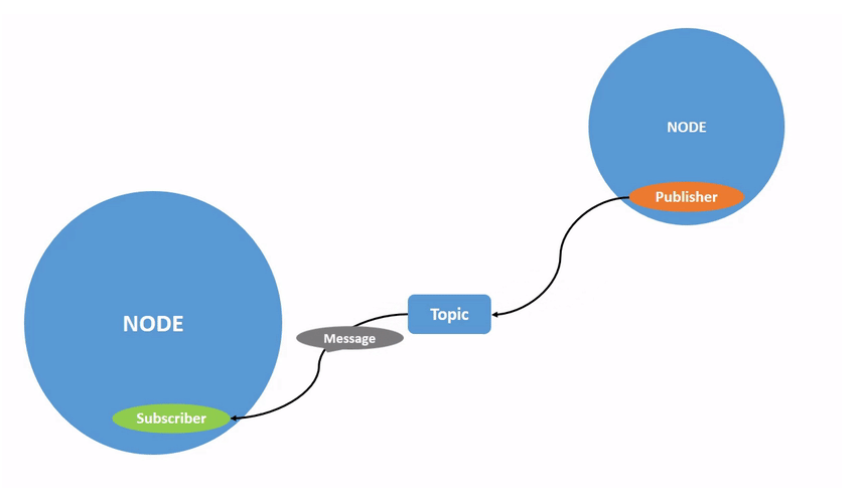編程方法
相比之前話題和服務(wù)的程序,動(dòng)作通信的例程相對(duì)較長(zhǎng),我們一起來(lái)運(yùn)行并分析一下。
運(yùn)行示例程序

$ source /opt/tros/local_setup.bash
$ source install/local_setup.bash
$ ros2 run learning_action_cpp server
$ ros2 run learning_action_cpp client
代碼解析
動(dòng)作的服務(wù)器fibonacci_action_server.cpp:
#include < inttypes.h >
#include < memory >
#include "learning_action_cpp/action/fibonacci.hpp"
#include "rclcpp/rclcpp.hpp"
// TODO(jacobperron): Remove this once it is included as part of 'rclcpp.hpp'
#include "rclcpp_action/rclcpp_action.hpp"
class MinimalActionServer : public rclcpp::Node
{
public:
using Fibonacci = learning_action_cpp::action::Fibonacci;
using GoalHandleFibonacci = rclcpp_action::ServerGoalHandle< Fibonacci >;
explicit MinimalActionServer(const rclcpp::NodeOptions & options = rclcpp::NodeOptions())
: Node("minimal_action_server", options)
{
using namespace std::placeholders;
this- >action_server_ = rclcpp_action::create_server< Fibonacci >(
this- >get_node_base_interface(),
this- >get_node_clock_interface(),
this- >get_node_logging_interface(),
this- >get_node_waitables_interface(),
"fibonacci",
std::bind(&MinimalActionServer::handle_goal, this, _1, _2),
std::bind(&MinimalActionServer::handle_cancel, this, _1),
std::bind(&MinimalActionServer::handle_accepted, this, _1));
}
private:
rclcpp_action::Server< Fibonacci >::SharedPtr action_server_;
rclcpp_action::GoalResponse handle_goal(
const rclcpp_action::GoalUUID & uuid,
std::shared_ptr< const Fibonacci::Goal > goal)
{
RCLCPP_INFO(this- >get_logger(), "Received goal request with order %d", goal- >order);
(void)uuid;
// Let's reject sequences that are over 9000
if (goal- >order > 9000) {
return rclcpp_action::GoalResponse::REJECT;
}
return rclcpp_action::GoalResponse::ACCEPT_AND_EXECUTE;
}
rclcpp_action::CancelResponse handle_cancel(
const std::shared_ptr< GoalHandleFibonacci > goal_handle)
{
RCLCPP_INFO(this- >get_logger(), "Received request to cancel goal");
(void)goal_handle;
return rclcpp_action::CancelResponse::ACCEPT;
}
void execute(const std::shared_ptr< GoalHandleFibonacci > goal_handle)
{
RCLCPP_INFO(this- >get_logger(), "Executing goal");
rclcpp::Rate loop_rate(1);
const auto goal = goal_handle- >get_goal();
auto feedback = std::make_shared< Fibonacci::Feedback >();
auto & sequence = feedback- >sequence;
sequence.push_back(0);
sequence.push_back(1);
auto result = std::make_shared< Fibonacci::Result >();
for (int i = 1; (i < goal- >order) && rclcpp::ok(); ++i) {
// Check if there is a cancel request
if (goal_handle- >is_canceling()) {
result- >sequence = sequence;
goal_handle- >canceled(result);
RCLCPP_INFO(this- >get_logger(), "Goal Canceled");
return;
}
// Update sequence
sequence.push_back(sequence[i] + sequence[i - 1]);
// Publish feedback
goal_handle- >publish_feedback(feedback);
RCLCPP_INFO(this- >get_logger(), "Publish Feedback");
loop_rate.sleep();
}
// Check if goal is done
if (rclcpp::ok()) {
result- >sequence = sequence;
goal_handle- >succeed(result);
RCLCPP_INFO(this- >get_logger(), "Goal Succeeded");
}
}
void handle_accepted(const std::shared_ptr< GoalHandleFibonacci > goal_handle)
{
using namespace std::placeholders;
// this needs to return quickly to avoid blocking the executor, so spin up a new thread
std::thread{std::bind(&MinimalActionServer::execute, this, _1), goal_handle}.detach();
}
}; // class MinimalActionServer
int main(int argc, char ** argv)
{
rclcpp::init(argc, argv);
auto action_server = std::make_shared< MinimalActionServer >();
rclcpp::spin(action_server);
rclcpp::shutdown();
return 0;
}
動(dòng)作的客戶端fibonacci_action_client.cpp:
#include < inttypes.h >
#include < memory >
#include < string >
#include < iostream >
#include "learning_action_cpp/action/fibonacci.hpp"
#include "rclcpp/rclcpp.hpp"
// TODO(jacobperron): Remove this once it is included as part of 'rclcpp.hpp'
#include "rclcpp_action/rclcpp_action.hpp"
class MinimalActionClient : public rclcpp::Node
{
public:
using Fibonacci = learning_action_cpp::action::Fibonacci;
using GoalHandleFibonacci = rclcpp_action::ClientGoalHandle< Fibonacci >;
explicit MinimalActionClient(const rclcpp::NodeOptions & node_options = rclcpp::NodeOptions())
: Node("minimal_action_client", node_options), goal_done_(false)
{
this- >client_ptr_ = rclcpp_action::create_client< Fibonacci >(
this- >get_node_base_interface(),
this- >get_node_graph_interface(),
this- >get_node_logging_interface(),
this- >get_node_waitables_interface(),
"fibonacci");
this- >timer_ = this- >create_wall_timer(
std::chrono::milliseconds(500),
std::bind(&MinimalActionClient::send_goal, this));
}
bool is_goal_done() const
{
return this- >goal_done_;
}
void send_goal()
{
using namespace std::placeholders;
this- >timer_- >cancel();
this- >goal_done_ = false;
if (!this- >client_ptr_) {
RCLCPP_ERROR(this- >get_logger(), "Action client not initialized");
}
if (!this- >client_ptr_- >wait_for_action_server(std::chrono::seconds(10))) {
RCLCPP_ERROR(this- >get_logger(), "Action server not available after waiting");
this- >goal_done_ = true;
return;
}
auto goal_msg = Fibonacci::Goal();
goal_msg.order = 10;
RCLCPP_INFO(this- >get_logger(), "Sending goal");
auto send_goal_options = rclcpp_action::Client< Fibonacci >::SendGoalOptions();
send_goal_options.goal_response_callback =
std::bind(&MinimalActionClient::goal_response_callback, this, _1);
send_goal_options.feedback_callback =
std::bind(&MinimalActionClient::feedback_callback, this, _1, _2);
send_goal_options.result_callback =
std::bind(&MinimalActionClient::result_callback, this, _1);
auto goal_handle_future = this- >client_ptr_- >async_send_goal(goal_msg, send_goal_options);
}
private:
rclcpp_action::Client< Fibonacci >::SharedPtr client_ptr_;
rclcpp::TimerBase::SharedPtr timer_;
bool goal_done_;
void goal_response_callback(std::shared_future< GoalHandleFibonacci::SharedPtr > future)
{
auto goal_handle = future.get();
if (!goal_handle) {
RCLCPP_ERROR(this- >get_logger(), "Goal was rejected by server");
} else {
RCLCPP_INFO(this- >get_logger(), "Goal accepted by server, waiting for result");
}
}
void feedback_callback(
GoalHandleFibonacci::SharedPtr,
const std::shared_ptr< const Fibonacci::Feedback > feedback)
{
RCLCPP_INFO(
this- >get_logger(),
"Next number in sequence received: %" PRId32,
feedback- >sequence.back());
}
void result_callback(const GoalHandleFibonacci::WrappedResult & result)
{
this- >goal_done_ = true;
switch (result.code) {
case rclcpp_action::ResultCode::SUCCEEDED:
break;
case rclcpp_action::ResultCode::ABORTED:
RCLCPP_ERROR(this- >get_logger(), "Goal was aborted");
return;
case rclcpp_action::ResultCode::CANCELED:
RCLCPP_ERROR(this- >get_logger(), "Goal was canceled");
return;
default:
RCLCPP_ERROR(this- >get_logger(), "Unknown result code");
return;
}
RCLCPP_INFO(this- >get_logger(), "Result received");
for (auto number : result.result- >sequence) {
RCLCPP_INFO(this- >get_logger(), "%" PRId32, number);
}
}
}; // class MinimalActionClient
int main(int argc, char ** argv)
{
rclcpp::init(argc, argv);
auto action_client = std::make_shared< MinimalActionClient >();
while (!action_client- >is_goal_done()) {
rclcpp::spin_some(action_client);
}
rclcpp::shutdown();
return 0;
}
聲明:本文內(nèi)容及配圖由入駐作者撰寫或者入駐合作網(wǎng)站授權(quán)轉(zhuǎn)載。文章觀點(diǎn)僅代表作者本人,不代表電子發(fā)燒友網(wǎng)立場(chǎng)。文章及其配圖僅供工程師學(xué)習(xí)之用,如有內(nèi)容侵權(quán)或者其他違規(guī)問(wèn)題,請(qǐng)聯(lián)系本站處理。
舉報(bào)投訴
-
機(jī)器人
+關(guān)注
關(guān)注
211文章
28524瀏覽量
207558 -
通信
+關(guān)注
關(guān)注
18文章
6043瀏覽量
136160 -
程序
+關(guān)注
關(guān)注
117文章
3792瀏覽量
81171
發(fā)布評(píng)論請(qǐng)先 登錄
相關(guān)推薦
機(jī)器人與編程的區(qū)別
在前一篇文章中講了機(jī)器人與編程的區(qū)別,但總感覺(jué)講的比較空泛,這篇文章繼續(xù)講講那些區(qū)別。計(jì)算機(jī)編程和機(jī)器人編程最大的區(qū)別就是一個(gè)是控制虛擬的,
發(fā)表于 09-01 07:12
機(jī)器人所用的線纜動(dòng)作
根據(jù)機(jī)器人的動(dòng)作選擇電纜首先請(qǐng)掌握電纜的動(dòng)作。配線時(shí)盡量加大彎曲半徑,減少扭轉(zhuǎn)和摩擦是減少斷線故障的要點(diǎn),然后根據(jù)該動(dòng)作下的期望壽命,選擇最合適的配線材料和配線
發(fā)表于 06-09 10:44
多節(jié)點(diǎn)大容量FPGA系統(tǒng)的遠(yuǎn)程升級(jí)方法
多節(jié)點(diǎn)大容量FPGA系統(tǒng)的遠(yuǎn)程升級(jí)方法:針對(duì)目前廣泛使用的以大容量FPGA 實(shí)現(xiàn)主要功能的多節(jié)點(diǎn)系統(tǒng)的遠(yuǎn)程升級(jí)問(wèn)題,提出了一種基于ATmega64 單片機(jī)和RS485 總線以及接入以太網(wǎng)的主控
發(fā)表于 11-20 17:42
?17次下載
多節(jié)點(diǎn)大容量FPGA系統(tǒng)的遠(yuǎn)程升級(jí)方法
多節(jié)點(diǎn)大容量FPGA系統(tǒng)的遠(yuǎn)程升級(jí)方法
針對(duì)目前廣泛使用的以大容量FPGA實(shí)現(xiàn)主要功能的多節(jié)點(diǎn)系統(tǒng)的遠(yuǎn)程升級(jí)問(wèn)題,提出了一種基于ATmega64單片機(jī)和RS485總
發(fā)表于 03-29 15:09
?824次閱讀

機(jī)器人多傳感器測(cè)距系統(tǒng)研究與設(shè)計(jì)
機(jī)器人多傳感器測(cè)距系統(tǒng)研究與設(shè)計(jì)......
發(fā)表于 12-23 14:46
?10次下載
機(jī)器人多傳感器信息融合測(cè)距系統(tǒng)設(shè)計(jì)
機(jī)器人多傳感器信息融合測(cè)距系統(tǒng)設(shè)計(jì)....
發(fā)表于 12-23 15:00
?16次下載
解讀機(jī)器人編程與機(jī)器人語(yǔ)言
機(jī)器人編程為使機(jī)器人完成某種任務(wù)而設(shè)置的動(dòng)作順序描述。機(jī)器人運(yùn)動(dòng)和作業(yè)的指令都是由程序進(jìn)行控制,常見(jiàn)的編制
機(jī)器人的最佳編程語(yǔ)言是什么?機(jī)器人十大流行編程語(yǔ)言匯總
機(jī)器人的主要特點(diǎn)之一是其通用性,是機(jī)器人具有可編程能力是實(shí)現(xiàn)這一特點(diǎn)的重要手段。機(jī)器人編程必然涉及機(jī)器人
常用的機(jī)器人編程方法有哪些
機(jī)器人編程【robotprogramming】為使機(jī)器人完成某種任務(wù)而設(shè)置的動(dòng)作順序描述。機(jī)器人運(yùn)動(dòng)和作業(yè)的指令都是由程序進(jìn)行控制,常見(jiàn)的編
發(fā)表于 08-15 17:41
?1.6w次閱讀
機(jī)器人編程是學(xué)的什么_機(jī)器人編程有什么前景
機(jī)器人編程為使機(jī)器人完成某種任務(wù)而設(shè)置的動(dòng)作順序描述。機(jī)器人運(yùn)動(dòng)和作業(yè)的指令都是由程序進(jìn)行控制,常見(jiàn)的編制
機(jī)器人多節(jié)點(diǎn)話題通信模型介紹
節(jié)點(diǎn)實(shí)現(xiàn)了機(jī)器人各種各樣的功能,但這些功能并不是獨(dú)立的,之間會(huì)有千絲萬(wàn)縷的聯(lián)系,其中最重要的一種聯(lián)系方式就是話題,它是節(jié)點(diǎn)間傳遞數(shù)據(jù)的橋梁。 通信模型 以兩個(gè)

機(jī)器人多節(jié)點(diǎn)話題通信編程方法
編程方法 了解了話題的基本原理,接下來(lái)我們就要開始編寫代碼啦。 創(chuàng)建工作空間 請(qǐng)大家先按照這個(gè)流程創(chuàng)建工作空間、下載課程的例程代碼,并進(jìn)行編譯。 $ mkdir –p dev_ws/src $ cd





 機(jī)器人多節(jié)點(diǎn)動(dòng)作通信編程方法
機(jī)器人多節(jié)點(diǎn)動(dòng)作通信編程方法










評(píng)論